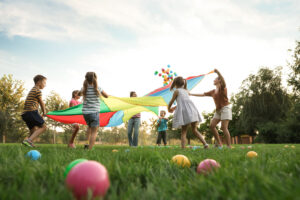Early learning is a pivotal stage in a child’s life. It’s where fundamental cognitive, language, and social skills are developed. Engaging in educational experiences at this stage is crucial for lifelong learning and development.
Outdoor play is an essential part of this learning process. It provides unique opportunities for physical growth, creative expression, and environmental awareness. Children gain practical experience in a natural setting, enhancing their overall development.
Benefits Of Outdoor Play
Outdoor play is an integral part of childhood, enriching early learning in myriad ways. Here are key benefits that highlight its importance in a child’s development.
- Physical Development
Outdoor activities naturally promote physical health in children. Climbing, running, and jumping enhance motor skills, balance, and coordination. These activities also improve overall fitness, build muscle strength, and increase endurance.
- Cognitive Skills Enhancement
Outdoor environments stimulate children’s cognitive skills. Navigating new spaces requires problem-solving and decision-making. Exploring nature boosts observation skills, encourages curiosity, and fosters a deeper understanding of scientific concepts.
- Social and Emotional Growth
Playing outdoors offers valuable social interactions. Children learn to cooperate, share, and negotiate with peers. They develop empathy and communication skills. This play also allows them to manage emotions, gain independence, and build confidence.
The significance of outdoor play in early learning is evident, aligning seamlessly with the principles of the EYLF Belmore. Such play is a vital component in developing well-rounded, resilient, and creative learners, preparing them for a lifetime of discovery and growth.
Integrating Outdoor Play In Early Education

Integrating outdoor play in early education is key to enhancing learning experiences. It brings a new dimension to traditional teaching methods.
- Strategies For Educators
Educators can enhance outdoor play by incorporating diverse, purposeful activities. They can create theme-based outdoor experiences, like a mini-beast hunt to learn about insects or a treasure hunt for developing map-reading skills. Using outdoor elements in storytelling or dramatization encourages imaginative thinking.
Educators can also organize structured physical activities, like obstacle courses, to develop coordination and strength. Regularly changing these activities keeps children engaged and curious. It’s also crucial to include child-led play, allowing children to explore and learn at their own pace.
Moreover, educators should be equipped with resources like field guides or art materials to facilitate these activities. They can also involve children in planning and setting up outdoor learning spaces, fostering a sense of ownership and responsibility.
Designing Effective Outdoor Spaces
Designing effective outdoor spaces in early education involves creating environments that are both safe and stimulating for children. These spaces should cater to various developmental needs and learning styles. Key elements include:
Safety And Accessibility: Ensure all areas are secure and accessible, including for children with different abilities. Use non-toxic plants and materials, and have clear sightlines for supervision.
Variety Of Play Areas: Incorporate different zones such as a sensory garden, a play structure, and a quiet reading area. This variety supports diverse activities and learning experiences.
Natural Elements: Include natural materials like sand, water, rocks, and plants. These elements encourage sensory play and connect children with nature.
Interactive Features: Add components that children can manipulate, like water tables, musical instruments, or movable blocks. These features stimulate creativity and problem-solving.
Adaptability: Design spaces that can be modified for different activities and age groups, ensuring long-term use and adaptability to changing educational needs.
By focusing on these aspects, educators can create outdoor spaces that are both fun and conducive to learning.
- Incorporating Play Into Curriculum
Integrating outdoor play into the curriculum requires innovative approaches. Educators can use nature-themed activities to teach various subjects. A nature scavenger hunt, for example, is ideal for introducing basic science concepts. It engages children in exploring and learning about different plant species and insects.
Another approach is using storytelling sessions in outdoor settings. This activity not only enhances language skills but also fosters imagination. Children can create their own stories inspired by their surroundings, which helps in developing creative thinking.
Mathematics can be taught through interactive outdoor games. Counting leaves or measuring the growth of plants introduces practical math skills. Sorting natural materials like stones and sticks aids in understanding basic mathematical concepts in a fun, engaging way.
Merging outdoor play with classroom lessons transforms education into an adventure. It sparks curiosity and excitement in young minds. This method gives children a chance to see, touch, and explore what they learn about, making every lesson memorable.
Challenges And Solution
Implementing outdoor play in early education presents unique challenges. However, effective solutions can address these issues.
- Addressing Safety Concerns
In early learning environments, particularly where both parents are working, safety becomes a paramount concern. These centers provide a safe haven for children, offering peace of mind to parents. By implementing rigorous safety protocols and consistent supervision, they ensure that children engage in outdoor play securely and in a nurturing environment.
- Overcoming Resource Limitations
Limited resources can be a hurdle. Creative use of existing outdoor spaces and community resources can be effective. Schools can also seek partnerships or grants to enhance outdoor learning environments.
- Engaging Diverse Learners
Outdoor play must cater to all children. Tailoring activities to suit different learning styles and abilities is key. Inclusive play areas and varied outdoor learning experiences can engage every child.
These challenges are surmountable with thoughtful planning and resourcefulness. Overcoming them ensures that outdoor play remains a valuable part of early learning.
Key Takeaway
Outdoor play in early education is more than just a break from the classroom. It’s a vital part of children’s learning and development. As we’ve explored, it enhances physical, cognitive, and emotional skills. It also provides practical challenges and solutions, making learning more engaging and relevant. It bridges the gap between theory and practice, making education a dynamic and enjoyable experience for children.




